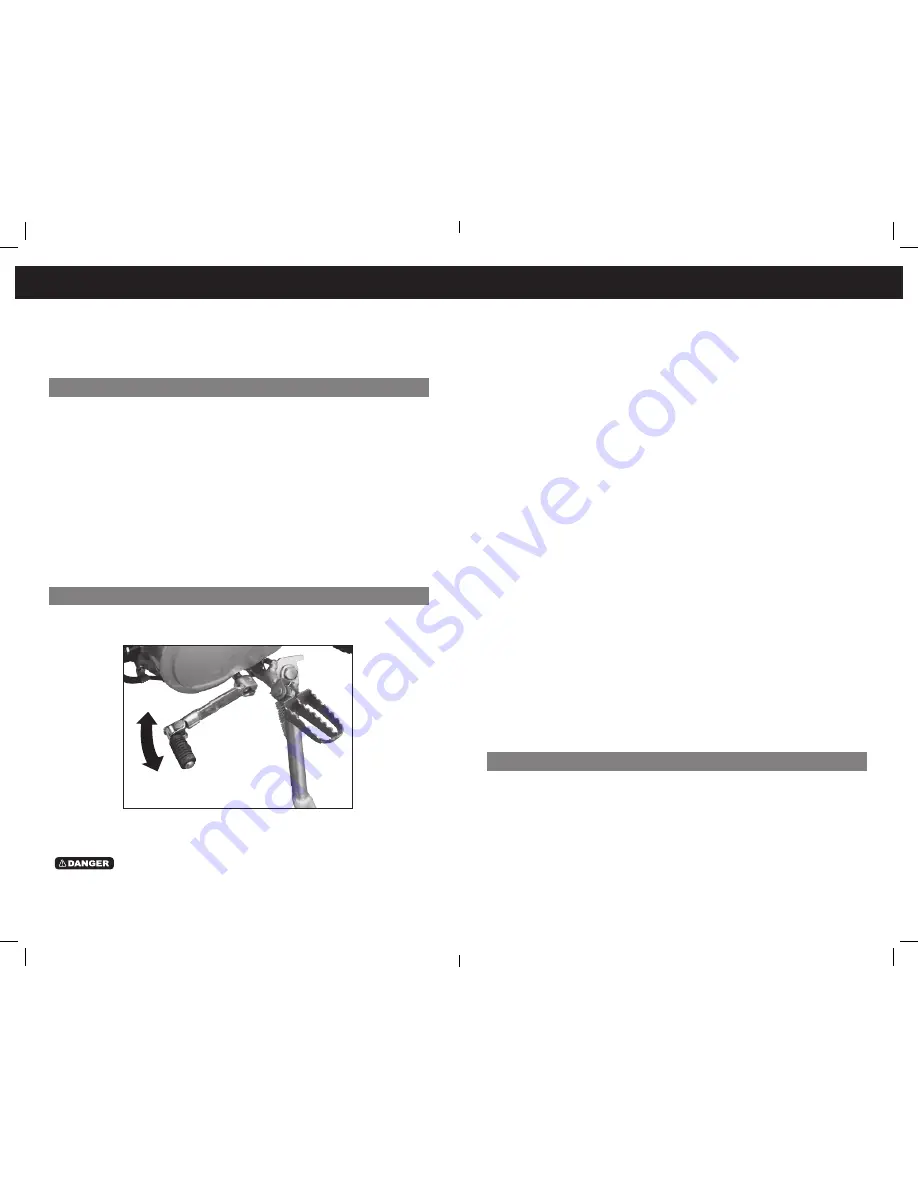
This dirt bike has four forward gears. To start riding, after the engine is fully warmed
up and the kickstand is raised, follow these steps.
1. With the engine running, squeeze the front brake tightly.
2. Push the shift lever down until you feel it click into first gear, then release the lever
and let it return to its neutral position.
3. Release the front brake and open the throttle slightly to increase the engine speed.
You will feel the dirt bike start to ease forward.
4. As the bike speed increases, let off on the throttle and push down on the shift lever
again until you feel it click into second gear. Once again, let the shifter return to its
neutral position and open the throttle a little to increase your speed.
5. To go faster, repeat this process to get to third and fourth gears.
NOTE: Learning when to shift up or down will come with experience and practice. Shift up
when you feel that the engine speed is getting high and you want to go faster. Shift down
when you want to slow the dirt bike down.
To downshift to a lower gear and slow down, let off on the throttle and pull up on the
shift lever until you feel it click. This will be the next lower gear.
The neutral position is before first gear. To return the dirt bike to neutral when it is in
gear, click up on the gear shifter as many times as needed to reach neutral.
Never attempt to start the engine when the dirt bike is in gear. Doing
so could cause a crash that could result in serious injury or death.
This section will cover basic braking technique for your dirt bike. To slow or
stop the bike, squeeze the front brake lever and push down on the rear brake
pedal firmly and smoothly. You can use engine speed to slow the bike along
with braking power by downshifting at the same time. Gradually increase
your braking pressure as you feel it is needed. The more pressure you apply
to the brakes, the more braking power will be applied. When you come to
a full stop, put your left foot on the ground first so that your right foot can
remain on the brake pedal as needed.
For maximum braking, let off completely on the throttle and firmly apply
both front and rear brakes at the same time while downshifting with your
left foot at the same time. Remember that on any motorcycle, the front brake
provides 60% - 70% of the braking power while the rear provides the rest, so
most of your braking power comes from the front brake. Just be careful to
apply it carefully to avoid sending the bike into a front wheel skid which will
cause you to lose control.
If you apply the brakes too quickly and start to skid, release the brakes to
regain control and then apply braking power carefully.
When riding on wet, or loose rocky conditions your braking power can be
reduced greatly and it will be much easier to put the bike into a skid and lose
control. If the surface is wet or loose, you must reduce your speed and allow
more room to stop safely.
Avoid jamming on the brakes suddenly or accelerating too quickly as either
of these actions can cause you to lose control of the dirt bike.
When descending a long, steep grade use engine compression to slow your
dirt bike by downshifting and using the brakes at the same time.
With the bike stopped, switch it off with the kill switch, flip down the kick-
stand and lean the bike over on it to park. Turn the Key Ignition to the off
position and turn the fuel valve to OFF. Always park your dirt bike on a flat
surface to avoid tipping over.
If you are going to store the dirt bike for an extended period of time, close
the fuel valve with the engine still running until it stops. This will burn all the
fuel out of the carburetor and reduce fuel system problems in the future.
DOWNSHIFTING AND STOPPING
STARTING AND UPSHIFTING
PARKING AND POST-RIDE INSPECTION
SHIFTING GEARS
BRAKING TECHNIQUE
17
16
BASIC OPERATION
Upshift
Downshift
TROUBLE
?
DO NOT RETURN TO STORE
contact us!
888-488-MOTO (6686)
or email [email protected]
Summary of Contents for MVX70
Page 26: ......












































